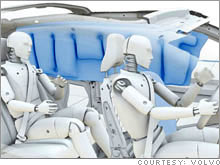NEW YORK (CNNMoney.com) -- It used to be horsepower. Then it was fuel economy. Now there's another number making its way into the big print in car ads: the number of airbags.
Already, Toyota is bragging about its "segment-leading" 10 airbags on the 2008 Lexus LX570 SUV. TV and magazine ads for cars and SUVs often tout the number of airbags as a competitive advantage.
 |
| Head-protecting side airbags shown in a mock-up of the Volvo C30. |
Autos
| 36 month new | 5.91% |
| 48 month new | 5.98% |
| 60 month new | 6.03% |
| 72 month new | 3.78% |
| 36 month used | 6.31% |
The obvious implication is that a car with more airbags is safer than one with fewer. If a car has 10 airbags while its competitor has only six, you can just imagine the sorts of injuries you could suffer with four fewer bags.
This is not to say that the LX570 will be anything other than very safe - just like every other Lexus vehicle. It's just that, in the end, airbag counting isn't the most useful way to gauge safety.
A car with six or eight airbags might protect every part of every occupant just as thoroughly as a car with 10. One long head-protecting side airbag can offer as much coverage for three rows of seats as three separate airbags.
Besides, airbags by themselves don't make a car safe. They're complex devices that work with a car's metal body and its seatbelts to protect occupants. Fewer, better designed airbags in a well-engineered car body are worth more than a whole bunch of airbags in a car that offers little protection on its own.
And the proof lies in crash test results from agencies like the government's National Highway Traffic Administration and the private Insurance Institute for Highway Safety.
No vehicle without head-protecting side airbags has ever earned a top rating in the Insurance Institute's side crash test. But it must be noted that some vehicles with them earned a Poor rating anyway. Again, airbags are vitally important, but they're not enough, by themselves, to insure your safety.
Since some types of airbags often come as extra-cost options rather than standard equipment, it's still good to know what all those airbags do and how. Sometimes fewer can be just as good as more.
Front airbags
Front airbags come out of the dashboard and protect the driver and front passenger in a front crash, and are required by law on all cars. But a few types of front airbags include slight changes that make the airbags themselves safer.
Early airbags actually resulted in injuries and even some deaths in what would have otherwise been minor accidents. In order to open quickly enough to protect occupants, the airbags opened with such explosive force that they could cause injuries - especially to small children or occupants who weren't seated far enough back from dashboard.
Many cars now have airbags that can open in different ways depending on what sensors detect about the size or position of the person in the seat. If sensors detect a small person, or that the person is leaning forward, the airbag can open slower or to a smaller size.
Side airbags
As the name suggests, side airbags protect occupants from getting hit from the side. Statistics prove that they're highly successful.
While airbags that protect occupants from the shoulders down reduce fatalities in side impacts by 26 percent, those that also protect their heads reduce fatalities by 37 percent, according to data from the Insurance Institute for Highway Safety.
In some SUVs, head-protecting side airbags serve an additional role. In rollover crashes, they can stay open longer to help protect occupants - or their heads and arms - from being thrown outside the vehicle.
Here's where those tricky airbag counts come in. Airbags that protect the head don't have to be separate from the ones that protect the ribs. A single airbag can protect an occupant's body while also reaching up to protect the head.
Either way, the protection should be just as good. Real-world crash data has not shown any advantage to systems that use separate head-and-torso airbags over those that use a single head-torso bag, according to the Insurance Institute.
Side airbags can also protect rear seat, as well as front seat, occupants. If a vehicle has head-protecting side airbags protecting the back seat passengers, they can be separate from those protecting front seat occupants. On the other hand, you might have side curtain airbags that cover two, or even three, rows of side windows. That's just as much protection as you'd get with two or three separate airbags.
Leg airbags
With more lives being saved by front airbags, leg injuries in front crashes have started getting more attention. Some cars now have airbags underneath the dashboard to protect occupants' knees and legs.
Whether or not these airbags are effective isn't really known yet, said David Zuby, the Insurance Institute's vice president of vehicle research. They may help out in vehicles where leg injuries would a problem otherwise. But so far, there is no evidence to show that people suffer fewer leg injuries in vehicles with them than without them. 